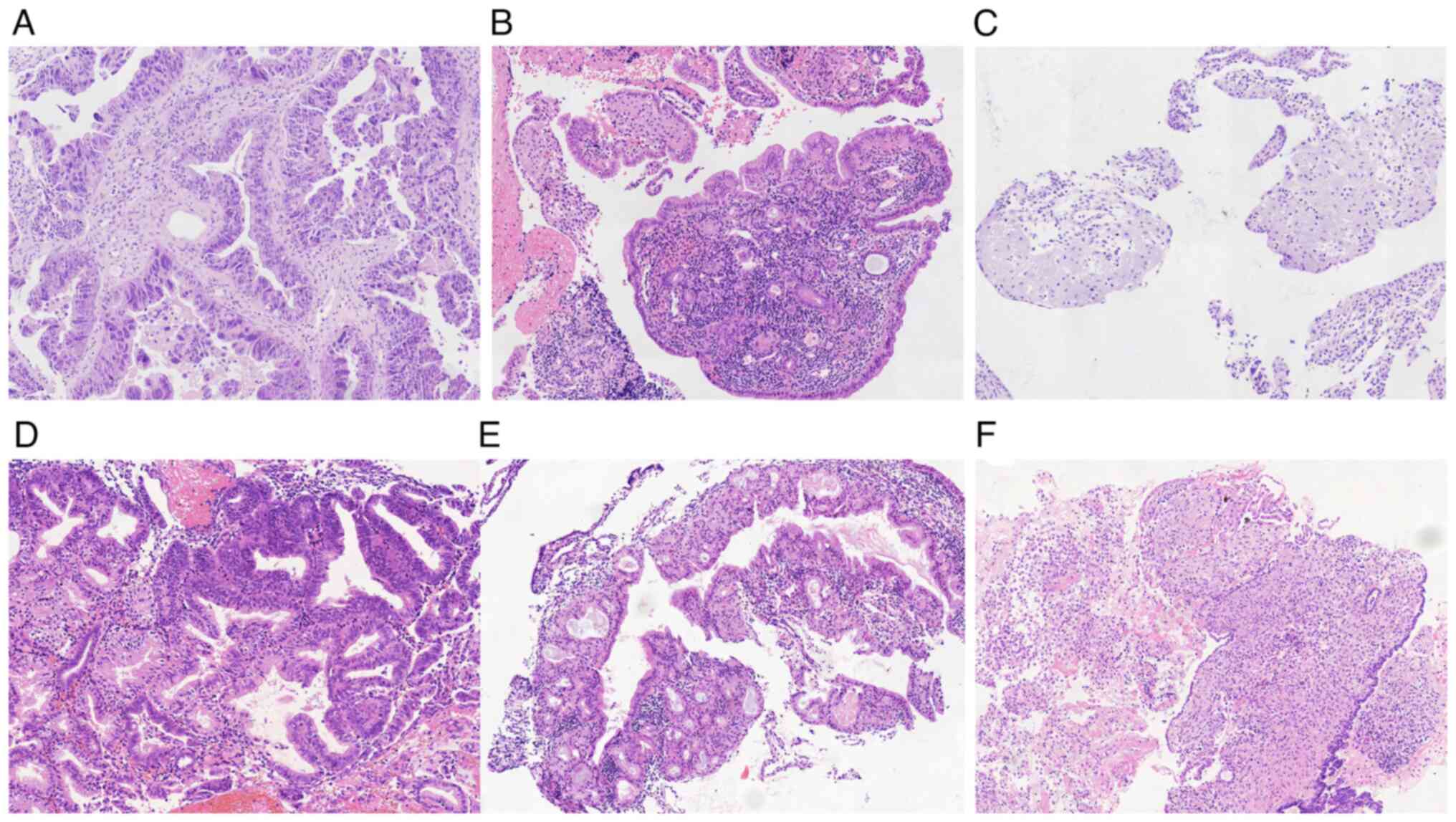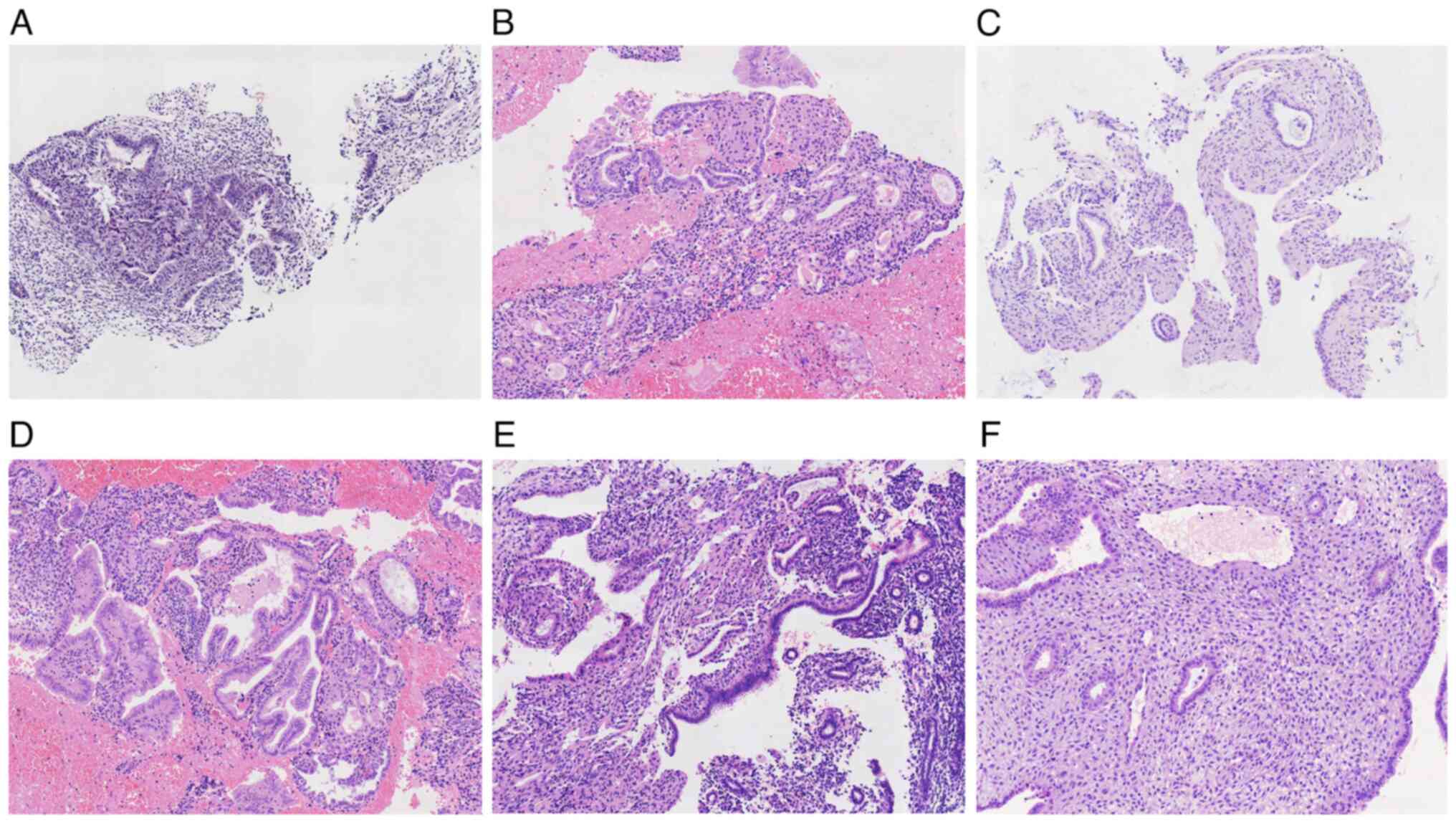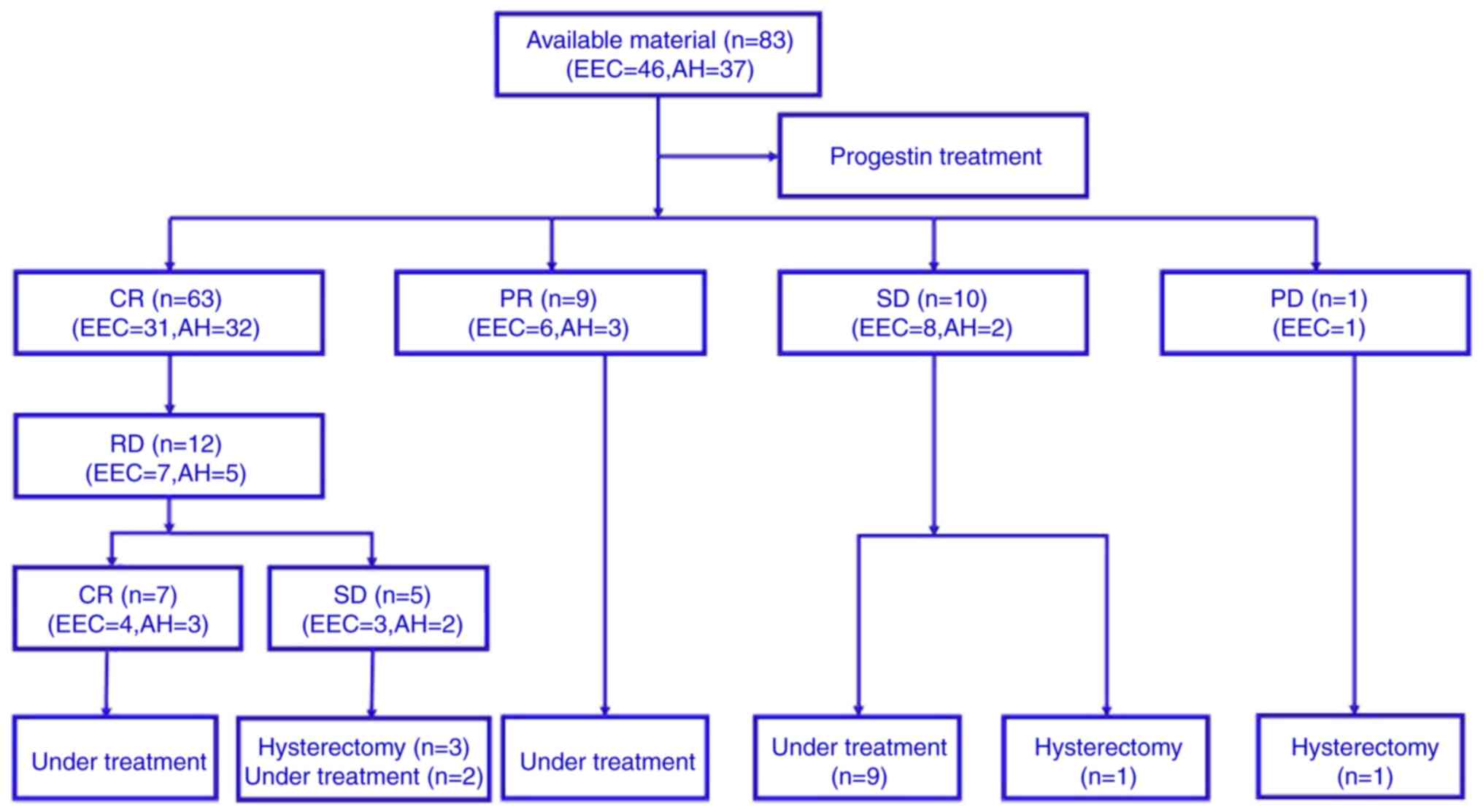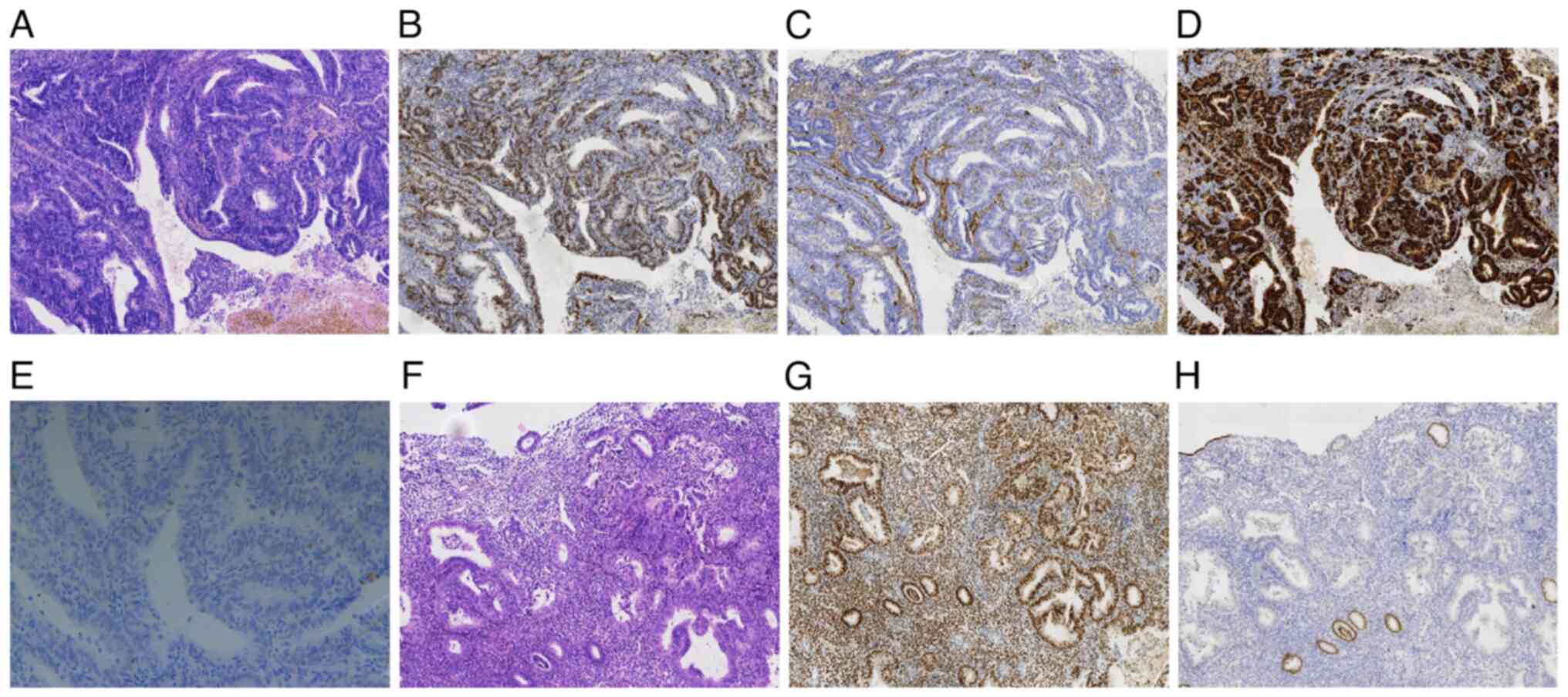|
1
|
Sung H, Ferlay J, Siegel RL, Laversanne M,
Soerjomataram I, Jemal A and Bray F: Global cancer statistics 2020:
GLOBOCAN estimates of incidence and mortality worldwide for 36
cancers in 185 countries. CA Cancer J Clin. 71:209–249. 2021.
View Article : Google Scholar : PubMed/NCBI
|
|
2
|
Sun P, Shen Y, Wang T, He Y, Zhang Y, Tian
W, Yang B and Hu Y: Distinct clinical and genetic mutation
characteristics in sporadic and Lynch syndrome-associated
endometrial cancer in a Chinese population. Cancer Epidemiol.
73:1019342021. View Article : Google Scholar : PubMed/NCBI
|
|
3
|
Kurman RJ, Carcangiu ML, Herrington CS and
Young RH: WHO Classification of Tumous of Female Reproductive
Organs. IARC Press; Lyon: 2014
|
|
4
|
Chen W, Zheng R, Baade PD, Zhang S, Zeng
H, Bray F, Jemal A, Yu XQ and He J: Cancer statistics in China,
2015. CA Cancer J Clin. 66:115–132. 2016. View Article : Google Scholar : PubMed/NCBI
|
|
5
|
Sanderson PA, Critchley H, Williams A,
Arends MJ and Saunders P: New Concepts for an Old Problem: The
Diagnosis of Endometrial Hyperplasia. Oxford University Press;
2016, View Article : Google Scholar
|
|
6
|
Coakley K, Wolford J and Tewari KS:
Fertility preserving treatment for gynecologic malignancies: A
review of recent literature. Curr Opin Obstet Gynecol. 32:51–56.
2020. View Article : Google Scholar : PubMed/NCBI
|
|
7
|
Corzo C, Barrientos Santillan N, Westin SN
and Ramirez PT: Updates on conservative management of endometrial
cancer. Obstet Gynecol Surv. 72:715–716. 2017. View Article : Google Scholar
|
|
8
|
Kim YB, Holschneider CH, Ghosh K, Nieberg
RK and Montz FJ: Progestin alone as primary treatment of
endometrial carcinoma in premenopausal women: Report of seven cases
and review of the literature. Cancer. 79:320–327. 1997. View Article : Google Scholar : PubMed/NCBI
|
|
9
|
Aristizabal P, Graesslin O, Barranger E,
Clavel-Chapelon F, Haddad B, Luton D, Darai E, Rouzier R and Koskas
M: A suggested modification to FIGO stage I endometrial cancer.
Gynecol Oncol. 133:192–196. 2014. View Article : Google Scholar : PubMed/NCBI
|
|
10
|
Moir-Meyer GL, Pearson JF and Lose F;
Australian National Endometrial Cancer Study Group, ; Scott RJ,
McEvoy M, Attia J, Holliday EG; Hunter Community Study; Studies of
Epidemiology and Risk Factors in Cancer Heredity, ; et al: Rare
germline copy number deletions of likely functional importance are
implicated in endometrial cancer predisposition. Hum Genet.
134:269–278. 2015. View Article : Google Scholar : PubMed/NCBI
|
|
11
|
Jerzak KJ, Duska L and Mackay HJ:
Endocrine therapy in endometrial cancer: An old dog with new
tricks. Gynecol Oncol. 153:175–183. 2019. View Article : Google Scholar : PubMed/NCBI
|
|
12
|
Quick CM, Laury AR, Monte NM and Mutter
GL: Utility of PAX2 as a marker for diagnosis of endometrial
intraepithelial neoplasia. Am J Clin Pathol. 138:678–684. 2012.
View Article : Google Scholar : PubMed/NCBI
|
|
13
|
Wheeler DT, Bristow RE and Kurman RJ:
Histologic alterations in endometrial hyperplasia and
well-differentiated carcinoma treated with progestins. Am J Surg
Pathol. 31:988–998. 2007. View Article : Google Scholar : PubMed/NCBI
|
|
14
|
Chen H, Lucas E, Strickland AL, Carrick K,
Gwin K, Castrillon DH, Rivera-Colon G, Niu S, Molberg KH and Zheng
W: Specific biomarker expression patterns in the diagnosis of
residual and recurrent endometrial precancers after progestin
treatment: A longitudinal study. Am J Surg Pathol. 44:1429–1439.
2020. View Article : Google Scholar : PubMed/NCBI
|
|
15
|
Bokhman JV: Two pathogenetic types of
endometrial carcinoma. Gynecol Oncol. 15:10–17. 1983. View Article : Google Scholar : PubMed/NCBI
|
|
16
|
Miller KD, Nogueira L, Mariotto AB,
Rowland JH, Yabroff KR, Alfano CM, Jemal A, Kramer JL and Siegel
RL: Cancer treatment and survivorship statistics, 2019. CA Cancer J
Clin. 69:363–385. 2019. View Article : Google Scholar : PubMed/NCBI
|
|
17
|
Koh WJ, Abu-Rustum NR, Bean S, Bradley K,
Campos SM, Cho KR, Chon HS, Chu C, Cohn D, Crispens MA, et al:
Uterine neoplasms, version 1.2018, NCCN clinical practice
guidelines in oncology. J Natl Compr Canc Netw. 16:170–199. 2018.
View Article : Google Scholar : PubMed/NCBI
|
|
18
|
Qin Y, Yu Z, Yang J, Cao D, Yu M, Wang Y
and Shen K: Oral Progestin Treatment for early-stage endometrial
cancer: A systematic review and meta-analysis. Int J Gynecol
Cancer. 26:1081–1091. 2016. View Article : Google Scholar : PubMed/NCBI
|
|
19
|
Wang Y, Yu M, Yang JX, Cao DY, Yuan Z,
Zhou HM, Zhang Y, Li L, Shen K and Wu H: Prolonged conservative
treatment in patients with recurrent endometrial cancer after
primary fertility-sparing therapy: 15-Year experience. Int J Clin
Oncol. 24:712–720. 2019. View Article : Google Scholar : PubMed/NCBI
|
|
20
|
Hwang JY, Kim DH, Bae HS, Kim ML, Jung YW,
Yun BS, Seong SJ, Shin E and Kim MK: Combined oral
medroxyprogesterone/levonorgestrel-intrauterine system treatment
for women with grade 2 stage IA endometrial cancer. Int J Gynecol
Cancer. 27:738–742. 2017. View Article : Google Scholar : PubMed/NCBI
|
|
21
|
Park JY, Kim DY, Kim TJ, Kim JW, Kim JH,
Kim YM, Kim YT, Bae DS and Nam JH: Hormonal therapy for women with
stage IA endometrial cancer of all grades. Obstet Gynecol.
122:7–14. 2013. View Article : Google Scholar : PubMed/NCBI
|
|
22
|
Fan Z, Li H, Hu R, Liu Y, Liu X and Gu L:
Fertility-preserving treatment in young women with grade 1 presumed
stage IA endometrial adenocarcinoma: A meta-analysis. Int J Gynecol
Cancer. 28:385–393. 2018. View Article : Google Scholar : PubMed/NCBI
|
|
23
|
Chen M, Jin Y, Li Y, Bi Y, Shan Y and Pan
L: Oncologic and reproductive outcomes after fertility-sparing
management with oral progestin for women with complex endometrial
hyperplasia and endometrial cancer. Int J Gynaecol Obstet.
132:34–38. 2016. View Article : Google Scholar : PubMed/NCBI
|
|
24
|
Rodolakis A, Biliatis I, Morice P, Reed N,
Mangler M, Kesic V and Denschlag D: European society of
gynecological oncology task force for fertility preservation:
Clinical recommendations for fertility-sparing management in young
endometrial cancer patients. Int J Gynecol Cancer. 25:1258–1265.
2015. View Article : Google Scholar : PubMed/NCBI
|
|
25
|
Srijaipracharoen S, Tangjitgamol S,
Tanvanich S, Manusirivithaya S, Khunnarong J, Thavaramara T,
Leelahakorn S and Pataradool K: Expression of ER, PR, and Her-2/neu
in endometrial cancer: A clinicopathological study. Asian Pac J
Cancer Prev. 11:215–220. 2010.PubMed/NCBI
|
|
26
|
Sherman ME: Theories of endometrial
carcinogenesis: A multidisciplinary approach. Mod Pathol.
13:295–308. 2000. View Article : Google Scholar : PubMed/NCBI
|
|
27
|
Raffone A, Travaglino A, Saccone G, Mollo
A, De Placido G, Insabato L and Zullo F: Should progesterone and
estrogen receptors be assessed for predicting the response to
conservative treatment of endometrial hyperplasia and cancer? A
systematic review and meta-analysis. Acta Obstet Gynecol Scand.
98:976–987. 2019. View Article : Google Scholar : PubMed/NCBI
|
|
28
|
Travaglino A, Raffone A, Saccone G,
Insabato L, Mollo A, De Placido G and Zullo F: Immunohistochemical
predictive markers of response to conservative treatment of
endometrial hyperplasia and early endometrial cancer: A systematic
review. Acta Obstet Gynecol Scand. 98:1086–1099. 2019. View Article : Google Scholar : PubMed/NCBI
|
|
29
|
Monte NM, Webster KA, Neuberg D, Dressler
GR and Mutter GL: Joint loss of PAX2 and PTEN expression in
endometrial precancers and cancer. Cancer Res. 70:6225–6232. 2010.
View Article : Google Scholar : PubMed/NCBI
|
|
30
|
Jing W, Zhang W, Feng L and Gao W:
Comparison of fertility-sparing treatments in patients with early
endometrial cancer and atypical complex hyperplasia: A
meta-analysis and systematic review. Medicine (Baltimore).
96:e80342017. View Article : Google Scholar : PubMed/NCBI
|
|
31
|
Cancer Genome Atlas Research Network, .
Kandoth C, Schultz N, Cherniack AD, Akbani R, Liu Y, Shen H,
Robertson AG, Pashtan I, Shen R, et al: Integrated genomic
characterization of endometrial carcinoma. Nature. 497:67–73. 2013.
View Article : Google Scholar : PubMed/NCBI
|
|
32
|
Horak P: Gene signature profiling of
gynaecological malignancies. Memo-Mag Eur Med Oncol. 7:252–255.
2014.
|


















